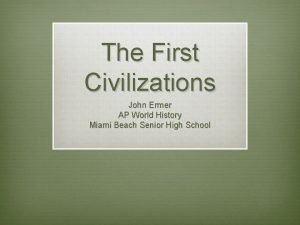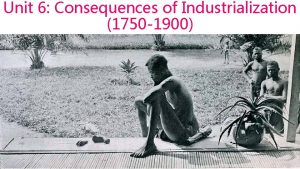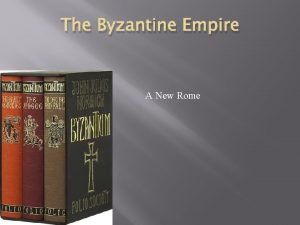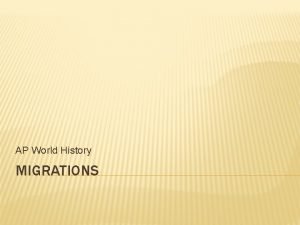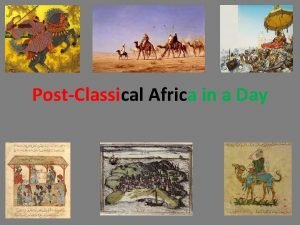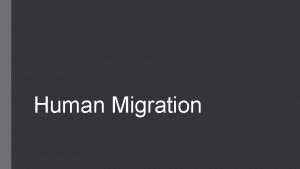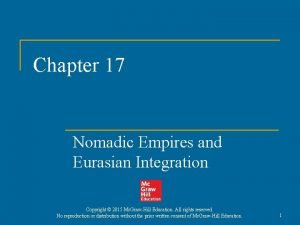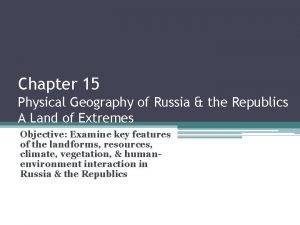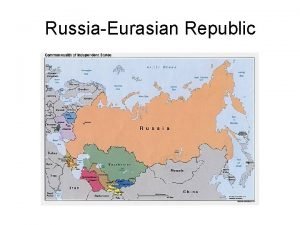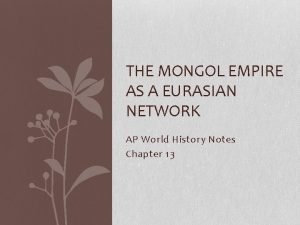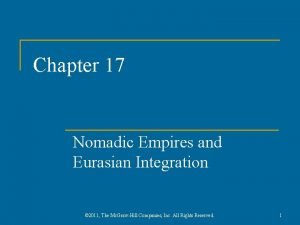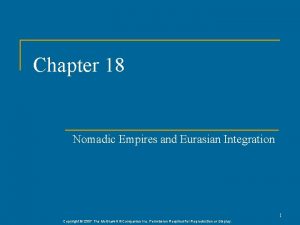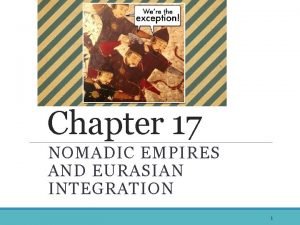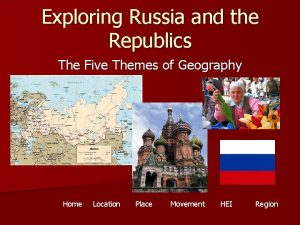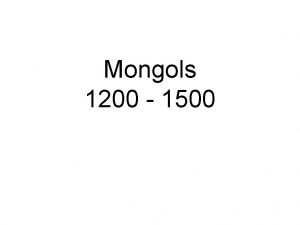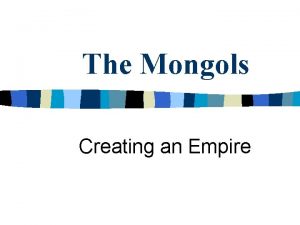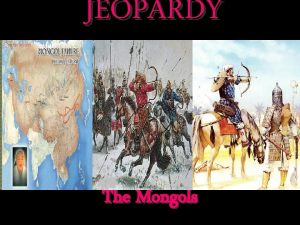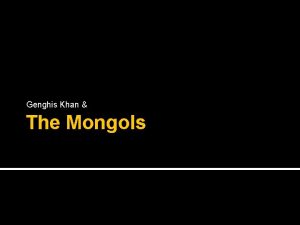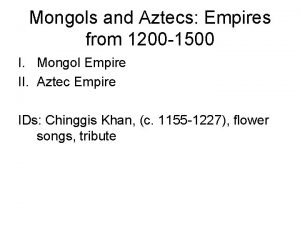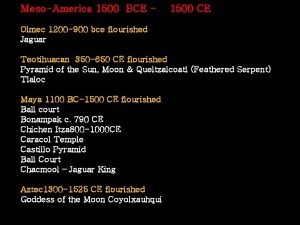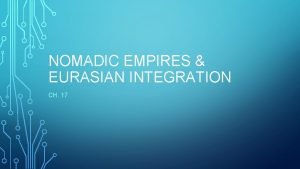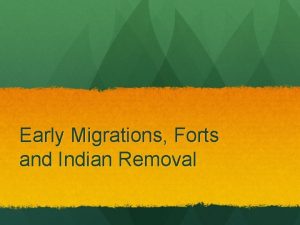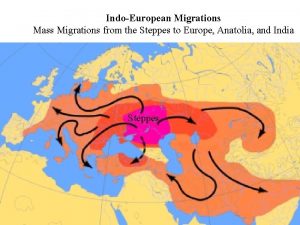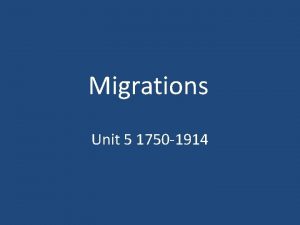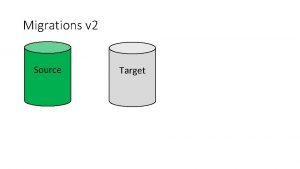The Mongols Eurasian Migrations 1200 1500 Mr Ermer















- Slides: 15

The Mongols & Eurasian Migrations 1200 -1500 Mr. Ermer World History AP Miami Beach Senior High

Happening Now v v Americas v 1325: Aztecs found Tenochtitlan v 1438 -1533: Inca Empire Europe v 1215: Magna Carta signed in England v 1337 -1453: Hundred Years War v 1454: Gutenberg Bible printed Middle East v 1258: Mongols attack Baghdad, end Abbassid Caliphate v 1453: Ottoman Turks conquer Constantinople Africa v 1324 -25: Mansa Musa’s pilgrimage to Mecca v 1499: Vasco da Gama rounds Africa

Rise & Rule of The Mongols v v Mongols: Turkic speaking pastoral nomads of Central Asia/Mongolia v Superb horsemen, herders, and hunters v Slave labor, tribute clans v Interfamily alliances + interfaith marriage= political federations v Self-sufficient with meat/milk, traded for iron v Khans spoke to and for God, shamanism v Mongol women give great respect and freedom relative to village women 1206 -1227: Genghis Khan, Temüjin, becomes Mongol leader v Promotes religious tolerance, cultural diversity and exchange, and harsh punishment for enemies v 1206 -1221: Empire stretches from China to Iran 1227 -1241: Reign of Great Khan Ögödei v Established capital at Karakorum v Tanggut and Jin China destroyed, replaced with Mongol governors v 1236 -1241: Batu conquers Kievan Russia, Moscow, Poland, and Hungary 1265: Family unity breaks down when Khublai declares himself Khan v 1271: Moves capital to Beijing, founds Yuan Empire in China v Other Mongols establish Islam in Central Asia, maintain inter-Turkic relations


Genghis’s Family of Khans Genghis Khan r. 1206 -1227 Jagadai Jochi r. 1227 -1242 Jagadai Khanate Ögödei Tolui r. 1227 -1241 Batu r. 1224 -1255 Golden Horde of Russia Güyük Möngke r. 1246 -1248 r. 1248 -1257 Khubilai Hülegü r. 1265 -1294 Yuan Emperor r. 1256 -1265 Il-khan Emperor

Mongol Domains, 1300

Mongols & Islam v Islamic culture destroyed with Mongol invasion of Baghdad v Cultures difficult to reconcile v Il-Kahn state founded by Hülegü in Persia v Shortly allied with Western European Crusader states in Palestine, Lebanon v Convert to Islam in 1295 v Khanate of Jagadai North Central Asia v Allied with Muslim Mamluk Turks, convert v Mongols adapt Muslim urbanism, tax system, science v Timur, commands Khanate of Jagadai, invades Middle East and India

Responses in Western Eurasia v Russia v Golden Horde rules from Sarai in south v v Alexander Nevskii favored by Mongols v v v Granted privileges to Orthodox Church Russian language dominates Russian princes = Mongol gov’t officials Novgorod & Moscow become trade centers Power and population shifts north Late 1400 s, Ivan III, Prince of Moscow, is tsar v Anatolia and Eastern Europe v Independent Eastern European kingdoms emerge (Lithuania, Serbia) v Ottoman Turks establish sultanate in Anatolia v 1453: Mehmet II conquers Constantinople, renamed Istanbul


Mongols In China v Great Khan Ögödei heavily taxes China, Khubilai Khan continues v Yuan successes: v Secure transportation & communication v Eurasian cultural & population exchange v Transmission of information, ideas, and skills v Acceptance of Chinese religion and culture v Tibetan Buddhist lamas become influential v Reunified China, Jin capital of Beijing established as great city v Mongol Social Structure: Mongols, Central Asians, Middle Easterners, Northern Chinese, Southern Chinese v Merchants enjoyed higher status than under traditional Chinese dynasties v Mongol infighting and Chinese farmer rebellion replaces Yuan Empire with Ming Dynasty v Independent clans still in control of Mongolia welcome Yuan refugees, new sense of Mongol unity established


Ming China v Buddhist Rebel Zhu Yuanzhang becomes Emperor Hongwu v Reestablishes traditional Chinese culture v v v v Some Mongol ideas linger (provinces, prof) Establishes Ming capital in Nanjing Espouses Confucian view of imperial power Declares war on “barbarians” Closes relations with Mid. East & Central Asia Silver replaces paper money Emperor Yongle (1403 -1424) reintroduces Mongol ideas v v v Returns capital to Beijing, improves Forbidden City Reopens relations with rest of Asia Funds maritime exploration (Zheng He) v Ming China not as innovative as Song China v Return of civil exam system discourages merchant class growth

East Asia & The Mongols v Japan and Annam escape Mongol rule v Mongol threat forces centralization v Korea conquered, local traditions thrive v Under Mongols, heavy Yuan influence v After Mongols, Korea est. Yi kingdom and trade, move capital to Seoul v Renew study of Confucian classics v Breakthrough in printing technology

Japan and Annam v Decentralized Japan inadequate against Mongols v Kamakura Shogunate centralizes, builds coastal defenses and communication/trade infrastructure v Ashikaga Shogunate decentralize power to local warlords, est. market towns, economy grows, Zen, urbanization, tech and artistic advancement v Annam v After Mongol rule, Annam conquers Champa v United Annam is foundation of modern Vietnam

 John ermer
John ermer Convict food
Convict food Types of migration
Types of migration Slavic migrations
Slavic migrations Bantu migrations ap world history
Bantu migrations ap world history Language bantu
Language bantu Bantu migrations definition
Bantu migrations definition Types of migrations
Types of migrations Chapter 17 nomadic empires and eurasian integration
Chapter 17 nomadic empires and eurasian integration Russia and the eurasian republics physical map
Russia and the eurasian republics physical map What are the 15 countries of the soviet union
What are the 15 countries of the soviet union The mongol empire as a eurasian network
The mongol empire as a eurasian network Chapter 17 nomadic empires and eurasian integration
Chapter 17 nomadic empires and eurasian integration Chapter 18 nomadic empires and eurasian integration
Chapter 18 nomadic empires and eurasian integration Nomadic empires and eurasian integration
Nomadic empires and eurasian integration Russia and the eurasian republics physical map
Russia and the eurasian republics physical map
